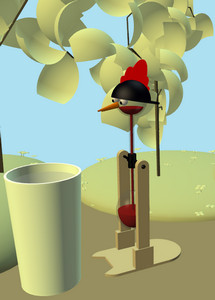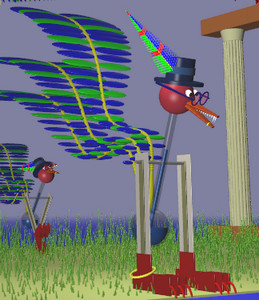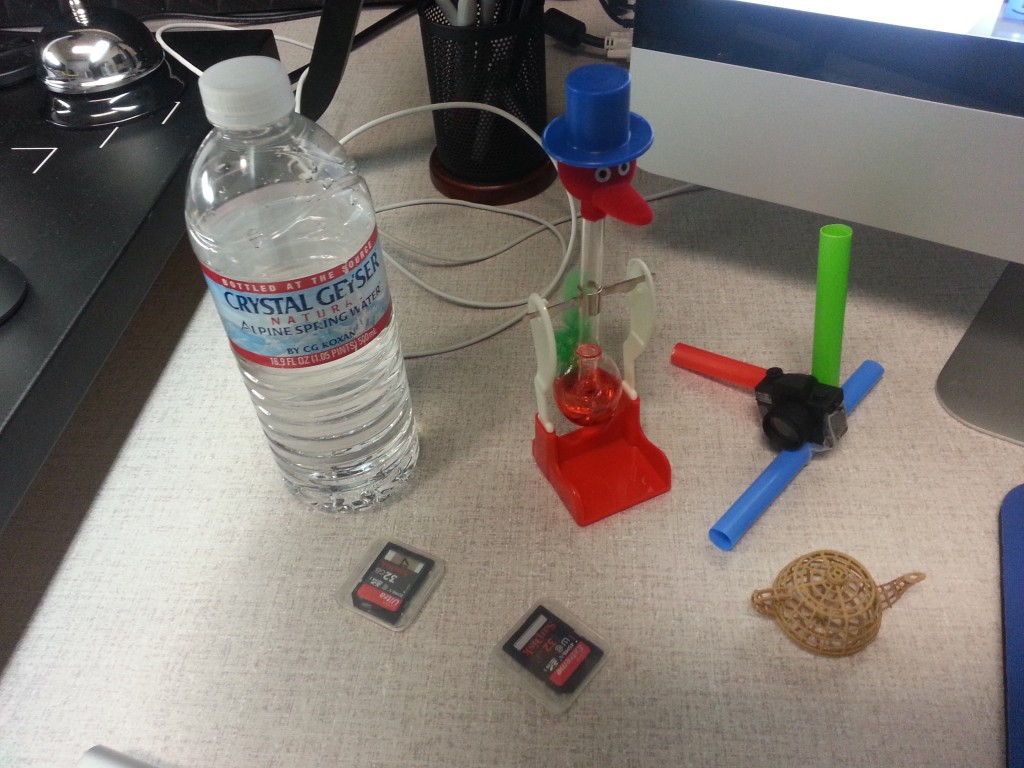Warning: This blog entry discusses adult content.
Last week Digg featured a news article titled "
Why Are Google, Apple And Amazon So Afraid Of Porn?" The
article discusses "America's Outdated Morals" and how Google Glass recently
changed their terms and conditions to prohibit sexual content.
The article quoted a Google spokesman (Chris Dale) as saying that, "Glass [is] built on Android, so it makes sense to adopt Android's broader policies" that prohibit "content that contains nudity, graphic sex acts, or sexually explicit material." The actual
developer's program policy says:
Sexually Explicit Material: We don't allow content that contains nudity, graphic sex acts, or sexually explicit material. Google has a zero-tolerance policy against child pornography. If we become aware of content with child pornography, we will report it to the appropriate authorities and delete the Google Accounts of those involved with the distribution.
The author of the Google Glass article (Andrea Garcia-Vargas) asked: "Why did they deem sexual explicitness a grounds for blocking a company? Why the anti-sexual explicitness philosophy? - I received no direct response." I cannot speak for Google, Apple, or Amazon, but I can speak for
FotoForensics. And I suspect that my answer is the same answer for those other companies.
Everyone is welcome... except you.
At FotoForensics, we permit nearly all types of content. Dancing kittens, political unrest, car accidents, and weird stuff from Reddit are all par for the course. But we draw the line at pornography, nudity, and sexually explicit content. The server is currently capable of automatically detecting some types of potentially prohibited content. A few things are automatically banned, while others are flagged for review. It isn't that we like to review porn. (I'm not kidding when I say that this is one of the two tasks that the admins
really dislike.) Rather, we have found that this type of content needs to be shut-down fast.
I had one banned user ask how we distinguish between a legitimate analysis of a questionable image that contains some nudity, and someone who just wants to upload porn. Our reply is simple: we don't distinguish. No porn, no nudity, no sexually explicit content.
The FotoForensics
FAQ (which doubles as a Terms of Service) explicitly and repeatedly states that it is a research site. Anything submitted will be used for research. As a research site, we are big fans of pattern analysis. People who upload sexually explicit content operate differently from people who upload other types of content. The differences show up in the submission rates, content quality, and variability. To put it simply, people who upload porn stand out as being very different from other users.
People who upload prohibit content make up a very small percent (less than 1%) of our user-base. Yet, they account for a constant stream of 2%-4% of uploaded content. During times when the admins were unavailable, porn submissions rapidly increased to 5%-10%. If left unchecked, it would quickly become 50% or more of the site's content.
This rapid growth from unchecked porn seems to be due to two factors. First, many of these people upload as much content as fast as possible. They are not interested in doing analysis; they just want a place to stash their porn. Second, they will tell their friends about the site and their friends will upload even more prohibited content.
Sexually explicit content isn't one of those things where people just upload one and stop. It is extremely rare for someone to upload a bunch of permitted content, one porn picture, and then more permitted content. Seriously -- the number of people who have done this over the last 1.5 years can be counted on one hand. On occasion we get people who upload a few random pictures and then switch over to prohibited content, but they don't seem to switch back and forth. Most of the time, people who upload prohibited content only upload prohibited content.
[Censored]
If you plan to run any kind of public, online service, then you must have a plan in place for dealing with porn. If you do nothing, then your site will quickly become 50% porn (or more). We've seen this with 4chan and The Pirate Bay -- where a lack of censorship results in a lot of content that isn't workplace safe.
And this leads to other problems...
For example, unless you are into some weird fetish, you probably don't want to see pictures of old people going at it. So most porn features photos of younger people. But how young? Thirties? Twenties? Late teens? Teens? Pre-teens? Child porn is a serious problem. If your site is porn friendly, then you are guaranteed to attract child pornographers. In the United States, service providers have a legal requirement to report child porn. Not reporting is a felony.
Hosting providers have a few options... They can never look at the content. However, there comes a point where you know what is going on, even if you're not actively reviewing content. (Gee, why are our the top referrals all coming from porn sites and 4chan? And why are all of our advertisers promoting adult content? And why are angry Mothers Against Child Molesters picketing outside our office?)
Providers could choose to not report it, but that's a felony when (not if) they get caught. Or service providers can report it (covering your ass but likely getting someone else arrested). At FotoForensics, we have a very basic policy: Report it. Don't evaluate, don't spend any time guessing whether the person is 17 or 18. If they look "young" then report it. This covers our legal responsibility.
And then there are blacklists... There are plenty of web services that provide lists of NSFW (not safe for work) sites. As an online service provider, getting blacklisted
will prevent some of your desirable clients from accessing your site. Large corporations and entire countries can be forbidden from accessing your site if you get blacklisted. So which is your preference?
- Option A: You can permit a small minority of users to get you blacklisted, which would restrict 50% of your desired and potential user base.
Or...
- Option B: You can ban less than 1% of users -- who account for a constant stream of 2%-4% content -- while the rest of the Internet can access the site.
I chose Option B.
As a research site, we want a variety of content. But without banning, we would become inundated by only one genre. While banning does introduce a bias, having a few users upload a ton of similar pictures would result in a much more extreme bias.
Et tu, Yahoo?
Today
news broke that Yahoo! has changed their
adult-content policy regarding Tumblr. Originally Yahoo said that they would not change Tumblr after the purchase, but reports now indicate that Yahoo had been making many changes recently. First they stopped search engines from indexing their "erotica" blogs, then they stopped returning all adult content from searches. The latest reports are that the erotica blogs have been deleted.
The news reports also indicate that roughly 10% of Tumblr's blogs were classified as adult content. At FotoForensics, a small percent of users account for a large amount of content. I suspect that the 10% of users accounted for around 50% (or more) of their content and traffic.
But there's more... There are many different blacklist systems out there. Most are paid services.
URLBlackList is a free one that can give you an idea how they work. This list contains a variety of domain names and URLs, classified into groups. Tumblr has been part of the 'adult' group for years. If you want to block adult content, you'd use this list and block hundreds of domains -- including Tumblr.
A few blacklists associate the parent company with the offending company. Yahoo could be feeling the effects of being blacklisted due to their acquisition of Tumblr.
Or maybe Yahoo's lawyers took a closer look at what is being hosted. With that much adult content, there's bound to be child porn... In fact, last week a Wisconsin man was
arrested for distributing child porn via Tumblr. Two days later, a
massive global sting netted over 250 people who traded in child pornography. I can't help but think that this timing with Yahoo is anything but coincidental. (Wait for the arrests, then shutdown the service.)
Then again, I'm not part of Yahoo and not privy to Tumblr's confidential plans. So who knows what is the actual driving force. I'm just speculating.
The White Wall Theory
A friend of mine (Jochen) likened the porn problem to graffiti on a white wall. If you do nothing, then there will be more graffiti. Then other types of crime will move into the area.
Crime surveys have repeatedly shown that burglary and violent crimes increase in areas with graffiti; removing the graffiti dramatically reduces the crime rate. In criminology circles, this is called the "
Broken windows theory".
Similarly, sites that don't block porn will quickly expand to hosting pictures of child porn, human trafficking, and other criminal activity. In contrast, blocking porn dramatically reduces the amount of child porn and other undesirable content.
The Digg headline asked "Why are Google, Apple and Amazon so afraid of porn?" The answer is simple: it's not fear, it's necessity. They can either keep their services clean and offer them to the entire world, or they can cater to sex offenders and other criminal elements who will choke-out desirable clients. Since there is more profit in offering their services to the workplace-safe community, they prohibit anything that could tarnish their walled gardens.





























